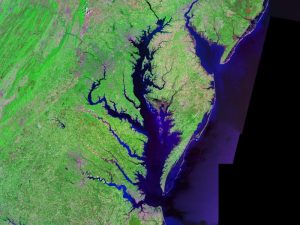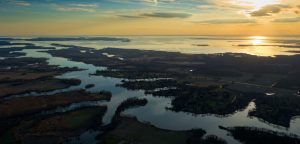Imagine a body of water so big you could fit the entire state of Rhode Island inside it – twice! That’s the Chesapeake Bay, the largest estuary in the United States and one of the most remarkable water systems in the world. When we take families out on charter boats near Annapolis, they’re often amazed to learn just how vast and diverse our Bay really is.

A Bay of Stunning Size
The Chesapeake Bay stretches an incredible 200 miles from its northern reaches in Maryland’s Susquehanna River all the way south to Virginia Beach, where it meets the Atlantic Ocean. At its widest point, the Bay spans nearly 30 miles – so far that you can’t see from one shore to the other! It has more than 11,600 miles of shoreline, which is more than the entire West Coast of the United States. If you could unfold all the Bay’s nooks and crannies, its shoreline would stretch from Annapolis to California and back again.
The Bay isn’t just long and wide – it’s also incredibly complex. More than 150 major rivers and streams flow into it, creating thousands of unique habitats. From the deep channels in the middle (some more than 170 feet deep) to the shallow waters near shore, from sandy beaches to muddy marshes, each area supports different kinds of life.
A World of Different Waters
What makes the Chesapeake Bay truly special is that it’s an estuary – a place where fresh and salt water mix. The fresh water flowing down from rivers meets salty ocean water pushing in from the Atlantic, creating water that ranges from nearly fresh in the north to almost as salty as the ocean in the south. This mixing creates different zones of saltiness that are like different neighborhoods for Bay creatures.
At the Bay’s mouth, the water is quite salty, perfect for ocean fish like bluefish and sea turtles that visit in summer. In the middle Bay, moderately salty water supports blue crabs, striped bass, and oysters. Up in the northern Bay and rivers, freshwater areas provide homes for white perch, catfish, and river otters. This variety of water types is one reason why so many different animals can live here.

Life in Every Layer
The Bay’s huge size and variety create homes for an amazing number of living things. More than 3,600 species of plants and animals live in and around the Bay! This includes:
- Over 350 species of fish, from tiny bay anchovies to huge Atlantic sturgeon
- Nearly 2,700 types of plants
- More than 300 species of birds
- Dozens of mammals, from river otters to bottlenose dolphins
- Countless microscopic organisms that form the base of the food web
The Bay is like a giant apartment building, with different creatures living at different levels. At the surface, ospreys dive for fish while herons wade in the shallows. Underwater, oysters build reefs that provide homes for small fish and crabs. In deeper channels, schools of striped bass hunt for food, while at the bottom, rays and flounder search for buried prey.
The Bay’s size and variety of habitats make it perfect for animals that move with the seasons. In spring, fish like shad and herring swim up rivers to spawn. Summer brings visits from sea turtles and rays. Fall sees massive bird migrations along the Bay’s shores. Even in winter, diving ducks and swans arrive from the north to feed in the Bay’s rich waters.
Protecting Our Water Wilderness
This vast water wilderness faces challenges. Such a large Bay connects to the lives of more than 18 million people who live in its watershed – the land area that drains into the Bay. Everything that happens on this land, from Baltimore to Richmond, from farms to cities, affects the Bay’s waters.
But there’s good news too. The Bay’s size means it has tremendous natural resilience. When we protect and restore key habitats like wetlands, underwater grass beds, and oyster reefs, the Bay’s natural systems can help it heal and thrive.
Remember, when you’re out on the Bay, you’re exploring one of Earth’s great water wildernesses. Every drop of water, every fish swimming past, every bird soaring overhead is part of an incredible system that stretches for hundreds of miles. The Chesapeake isn’t just a bay – it’s a world of water, waiting to be discovered and protected for future generations to enjoy.
